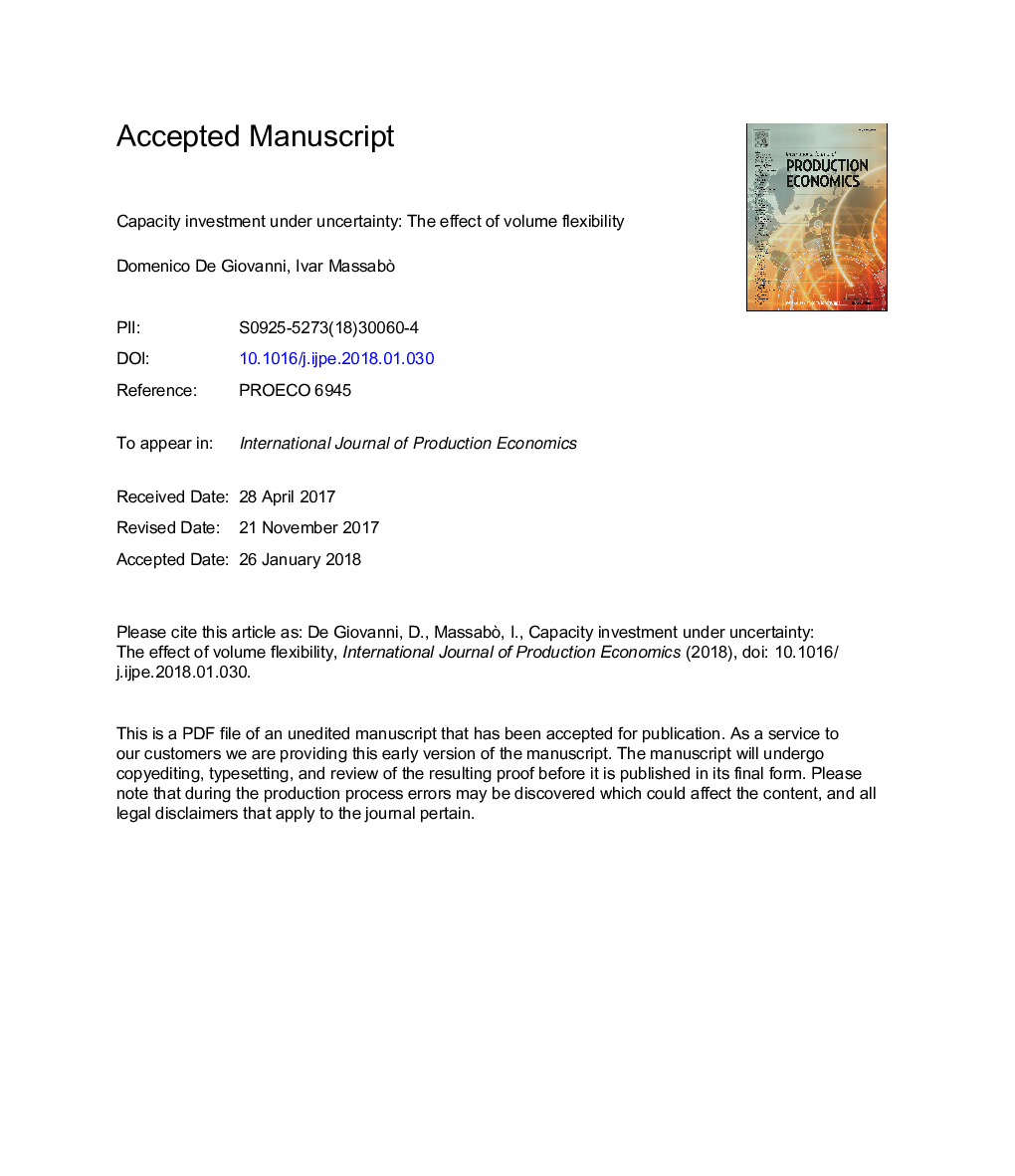| کد مقاله | کد نشریه | سال انتشار | مقاله انگلیسی | نسخه تمام متن |
|---|---|---|---|---|
| 7355248 | 1477506 | 2018 | 34 صفحه PDF | دانلود رایگان |
عنوان انگلیسی مقاله ISI
Capacity investment under uncertainty: The effect of volume flexibility
ترجمه فارسی عنوان
سرمایه گذاری ظرفیت نااطمینانی: اثر انعطاف پذیری حجم
دانلود مقاله + سفارش ترجمه
دانلود مقاله ISI انگلیسی
رایگان برای ایرانیان
کلمات کلیدی
گزینه های واقعی سرمایه گذاری ظرفیت انعطاف پذیری دوره
ترجمه چکیده
تئوری گزینه واقعی یک ابزار اصلی در نظریه سرمایه گذاری امروز است زیرا عدم اطمینان و انعطاف پذیری مدیریتی را در تحلیل و ارزیابی پروژه های سرمایه گذاری ادغام می کند. این مقاله زمان و اندازه مطلوب سرمایه گذاری را برای یک شرکت انحصارطلب تحت عدم اطمینان تقاضا و انعطاف پذیری حجم مطالعه می کند. در چارچوب مدل سازی ما، تقاضا به صورت تصادفی است و شرکت برای اولین بار زمان و اندازه مطلوب فرایند تولید را تعیین می کند. بعد از ورود، شرکت به طور مداوم حجم تولید را برای مطابقت با تقاضای مورد نظر تنظیم می کند. انعطاف پذیری دوره ای با هزینه ای است که بستگی به خروجی فعلی و ظرفیت ایجاد شده دارد. ما دو مدل مختلف انعطاف پذیری حجم را مطالعه می کنیم: انعطاف پذیری حجم ضعیف اجازه می دهد که شرکت ها هر مقدار کمتری نسبت به ظرفیت نصب شده تولید کنند؛ انعطاف پذیری حجم به بالا اجازه می دهد تا تولید بیش از اندازه ظرفیت شرکت را گسترش دهد. در هر دو مورد، گزینه ای برای موقت تعلیق تولید به طور پیش فرض نیست، اما این بخشی از انتخاب مطلوب شرکت است. با استفاده از این ویژگی، مدل نتیجه گیری را ارائه می دهد که برخلاف یافته های نظری اخیر در مورد یک موضوع است. ما دریافتیم که افزایش میزان انعطاف پذیری حجم نازل باعث می شود که شرکت تمایل داشته باشد قبل از آن در یک کارخانه بزرگتر سرمایه گذاری کند. ما همچنین نشان می دهیم که انعطاف پذیری حجم نزولی نرخ بهره را کاهش می دهد، به ویژه در بازارهای بسیار نا مشخص. انعطاف پذیری حجم بالا باعث کاهش حجم سرمایه گذاری و آستانه سرمایه گذاری می شود که شرکت ظرفیت آن را نصب می کند. نرخ بهره در مقایسه با موارد انعطاف پذیری حجم نزولی بطور قابل توجهی بالاتر است و بین افزایش انعطاف پذیری و میزان بهره وری افزایش می یابد.
موضوعات مرتبط
مهندسی و علوم پایه
سایر رشته های مهندسی
مهندسی صنعتی و تولید
چکیده انگلیسی
Real option theory is a central tool in today's investment theory as it integrates uncertainty and managerial flexibility in the analysis and valuation of investment projects. This paper studies the optimal time and size of investment for a monopolistic firm under demand uncertainty and volume flexibility. In our modeling framework, demand is random and the firm first decides the optimal time and size of the production process. After entry, the firm adjusts continuously production volume to match the observed demand. Volume flexibility comes at a cost which depends on both the current output and the established capacity. We study two different models of volume flexibility: Downside volume flexibility allows the firms to produce any quantity below the installed capacity; Upside volume flexibility allows to expand production above the firm's capacity size. In both cases, the option to temporary suspend production is not given a priori, but it is part of the firm's optimal choice. With this feature, the model provides conclusions that contrast some of the most recent theoretical findings on the same subject. We find that an increase of the degree of downside volume flexibility makes the firm willing to invest earlier in a larger plant. We also show that downside volume flexibility reduces the utilization rates, especially in highly uncertain markets. Upside volume flexibility has the joint effect of reducing the size of the investment and the investment threshold at which the firm installs capacity. The utilization rates are significantly higher compared to the case of downside volume flexibility only, and there is an increasing relationship between increased upside flexibility and utilization rates.
ناشر
Database: Elsevier - ScienceDirect (ساینس دایرکت)
Journal: International Journal of Production Economics - Volume 198, April 2018, Pages 165-176
Journal: International Journal of Production Economics - Volume 198, April 2018, Pages 165-176
نویسندگان
Domenico De Giovanni, Ivar Massabò,
